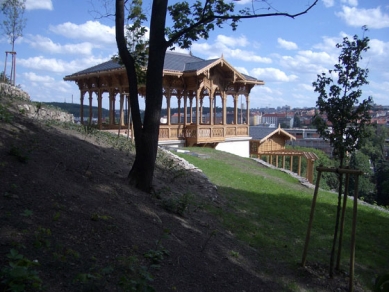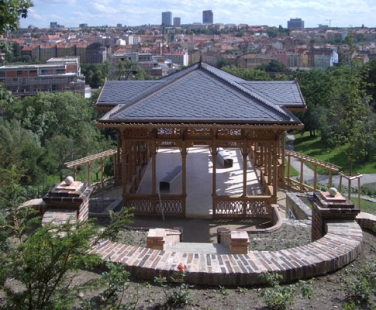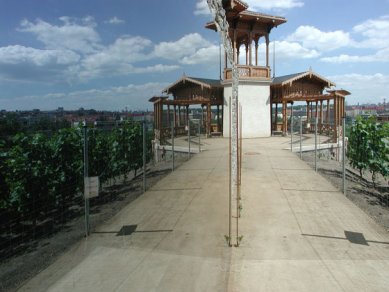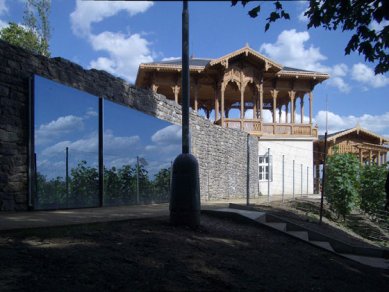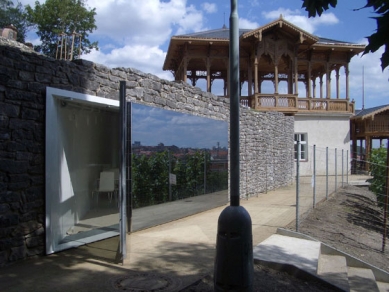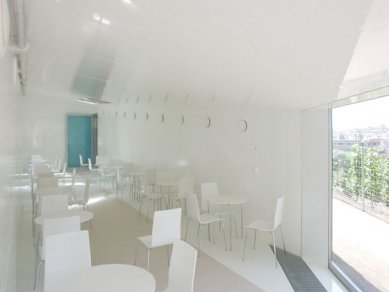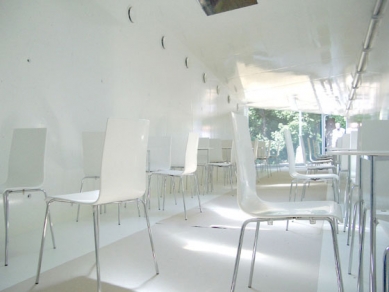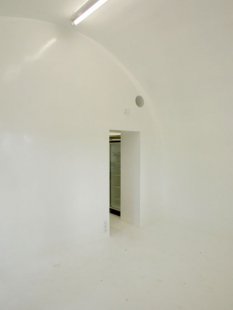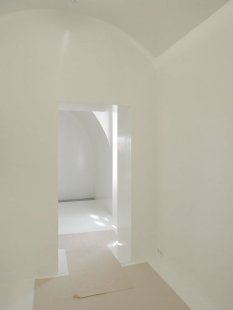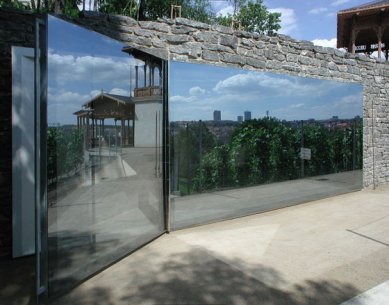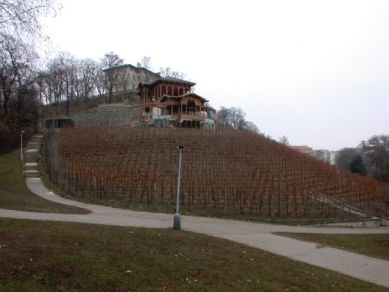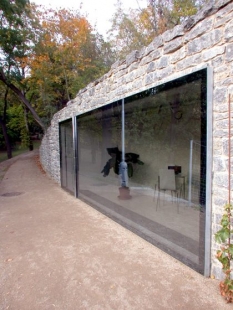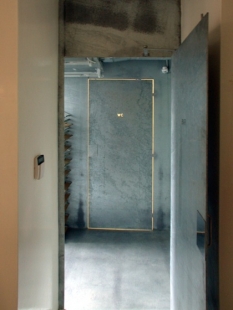
<Viniční altán> translates to <Vineyard gazebo>

The object of the vineyard gazebo in today's Havlíčkovy Sady city park was built according to the designs of architects Antonín Barvitia and Josef Schulze, as part of the summer residence of industrialist Moritz Gröbe, constructed between 1871 and 1888.
The assignment was to completely restore the ruins of the gazebo and expand it for year-round operation as a café and wine bar. We proposed the necessary enlargement of the internal spaces by freely developing Barviti's floor plan into the slope below the terrain. This way, we excluded any above-ground extension. We did not want to change the existing external silhouette of the gazebo situated in the slope with the vineyard. The newly designed underground space touches the external surface at a significant distance from Barviti's gazebo.
The entrances of this underground space are therefore at a non-confrontational distance from the gazebo. We documented the fragments of the original wooden elements and new parts were made according to templates for a complete replica of the entire Barviti wooden structure.
The internal spaces and furnishings are completely autonomous and contemporarily processed.
The history of this Prague vineyard dates back according to legends deep into the Middle Ages. It is said that its establishment was taken care of by Charles IV himself; according to other legends, the story is even older. However, let us leave speculation and look at the current state, when architects made a complete replica of the vineyard gazebo of Antonín Barvitia and Josef Schulze, which is now a protected cultural monument.
Dr. Švácha often talks about the atelier's skills in placing modern gems into historical environments during his lectures. This instance was no different, at least regarding the external expression. With healthy boldness, they newly conceived the base under Barviti's gazebo. The added mass is entirely buried underground and only surfaces at a respectful distance from the pavilion. I will have to come to terms with the long white room for quite some time. The concrete walls, ceiling, and floor are painted white, which still emits an unpleasant odor two months after the opening. The authors probably aimed for the most illuminated environment possible in the long underground hill. However, one only needs to remember the wine cellars in southern Moravia, which have no windows and do not even try to provide light. Those who want light can enjoy drinks under the pergolas in front of the gazebo.
A deeper connection between the building and the architect is evidenced by the fact that the author got married in it. It is not common for you to marry in each of your realizations, and not every type of building allows this. Here, it happened rarely.
Architectural magazines should not write about the gourmet offerings of the gazebo (cheeses and pâtés), so you should visit and taste for yourself.
Causa Grébovka
The owner of the area is the municipality of the Capital City of Prague, part of the land is entrusted to the Prague 2 City District, which announced a one-stage public commercial competition on October 25, 2000, for the selection of the most suitable investor for the reconstruction and simultaneously a tenant of the Havlíčkovy Sady area. The Prague 2 municipality is inclined towards the only participant in the competition - a foundation established by American lawyers, which intends to establish a center for legal education in Prague, and the conservatory is threatened with eviction. No park is profitable. Even in cases where an entrance fee is collected, the revenue usually does not even cover the operating costs. The same can be said about culture and education. Renting, whose goal is to try to gain as many funds as possible, has nothing to do with charity. The client buys the right to use the area for themselves in a way that will recoup their investments. Thus, a part of the function, which makes Gröbovka a facility serving the public, is sold. The restoration and maintenance of the garden from public funds is in the interest of the citizens. However, announcing a competition for the lease of the park with the subtitle "investment opportunity" is the highest degree of disgrace on the part of the municipality. Since 2002, everything has played into the hands of the American lawyer company.
History of Grébovka
Moritz Gröbe was a wealthy man. In Královské Vinohrady, he acquired an extensive property on the grounds of two vineyard estates (Upper and Lower Landhausky) and between 1871 and 1888 had a lavish neo-renaissance villa built there according to the design of Antonín Barvitia and Josef Schulze. Other buildings that facilitated the operation of the main house were also constructed on the site. An English park was established over an area of nearly 80,000 square meters, in its western part there was a grotto, an artificial cave with a rocky outcrop and a fountain (which housed a statue of Neptune by Bohumil Schnirch). There is also the Vineyard gazebo built according to the design of Josef Schulze, who was primarily involved in the completion of the interiors and supplementary buildings in Gröbovka. The gazebo was constructed concurrently with Gröbe's villa on two levels on a smaller stone terrace embedded in the steep slope of the vineyard. From 1902 to 1905, the granddaughter of Emperor Franz Joseph I, Elizabeth of Habsburg, lived here with her husband Karl Otto Windischgrätz. When the entire property passed into the ownership of the Vinohrady municipality in 1905, out of fear of parceling off the gardens with the construction of apartment buildings, it was named Havlíčkovy Sady and ceremoniously opened to the public on May 16, 1906. A restaurant was set up in the Grotto. The villa itself long served as a teaching facility for the University of Forestry. 1937 - At the expense of the capital city, a children's excursion home was established in the villa, named after the first mayor of Greater Prague. 1939 - the villa was occupied by the Hitler Youth. 1945 - during American bombing, Gröbe's villa was directly hit. A fire nearly destroyed it. The park also received several hits, into which animals escaped from the damaged zoo. It was restored in the early 1950s when architect Pavel Smetana converted it into a House of Pioneers and Youth. After 1989, it remained empty for several years. It is now partly leased to a Private Dance Conservatory, which is an eight-year secondary art school that combines general education with specialized subjects such as dance, piano, and acting training. 1992-93 - the destroyed vineyard in Gröbovka was restored. 2002-03 - the first phase of the reconstruction of Gröbe's villa. 2002-04 - the reconstruction of the Vineyard gazebo.
The assignment was to completely restore the ruins of the gazebo and expand it for year-round operation as a café and wine bar. We proposed the necessary enlargement of the internal spaces by freely developing Barviti's floor plan into the slope below the terrain. This way, we excluded any above-ground extension. We did not want to change the existing external silhouette of the gazebo situated in the slope with the vineyard. The newly designed underground space touches the external surface at a significant distance from Barviti's gazebo.
The entrances of this underground space are therefore at a non-confrontational distance from the gazebo. We documented the fragments of the original wooden elements and new parts were made according to templates for a complete replica of the entire Barviti wooden structure.
The internal spaces and furnishings are completely autonomous and contemporarily processed.
Marek Chalupa, 12.09.2004
The history of this Prague vineyard dates back according to legends deep into the Middle Ages. It is said that its establishment was taken care of by Charles IV himself; according to other legends, the story is even older. However, let us leave speculation and look at the current state, when architects made a complete replica of the vineyard gazebo of Antonín Barvitia and Josef Schulze, which is now a protected cultural monument.
Dr. Švácha often talks about the atelier's skills in placing modern gems into historical environments during his lectures. This instance was no different, at least regarding the external expression. With healthy boldness, they newly conceived the base under Barviti's gazebo. The added mass is entirely buried underground and only surfaces at a respectful distance from the pavilion. I will have to come to terms with the long white room for quite some time. The concrete walls, ceiling, and floor are painted white, which still emits an unpleasant odor two months after the opening. The authors probably aimed for the most illuminated environment possible in the long underground hill. However, one only needs to remember the wine cellars in southern Moravia, which have no windows and do not even try to provide light. Those who want light can enjoy drinks under the pergolas in front of the gazebo.
A deeper connection between the building and the architect is evidenced by the fact that the author got married in it. It is not common for you to marry in each of your realizations, and not every type of building allows this. Here, it happened rarely.
Architectural magazines should not write about the gourmet offerings of the gazebo (cheeses and pâtés), so you should visit and taste for yourself.
Petr Šmídek, 12.16.2004
Causa Grébovka
The owner of the area is the municipality of the Capital City of Prague, part of the land is entrusted to the Prague 2 City District, which announced a one-stage public commercial competition on October 25, 2000, for the selection of the most suitable investor for the reconstruction and simultaneously a tenant of the Havlíčkovy Sady area. The Prague 2 municipality is inclined towards the only participant in the competition - a foundation established by American lawyers, which intends to establish a center for legal education in Prague, and the conservatory is threatened with eviction. No park is profitable. Even in cases where an entrance fee is collected, the revenue usually does not even cover the operating costs. The same can be said about culture and education. Renting, whose goal is to try to gain as many funds as possible, has nothing to do with charity. The client buys the right to use the area for themselves in a way that will recoup their investments. Thus, a part of the function, which makes Gröbovka a facility serving the public, is sold. The restoration and maintenance of the garden from public funds is in the interest of the citizens. However, announcing a competition for the lease of the park with the subtitle "investment opportunity" is the highest degree of disgrace on the part of the municipality. Since 2002, everything has played into the hands of the American lawyer company.
History of Grébovka
Moritz Gröbe was a wealthy man. In Královské Vinohrady, he acquired an extensive property on the grounds of two vineyard estates (Upper and Lower Landhausky) and between 1871 and 1888 had a lavish neo-renaissance villa built there according to the design of Antonín Barvitia and Josef Schulze. Other buildings that facilitated the operation of the main house were also constructed on the site. An English park was established over an area of nearly 80,000 square meters, in its western part there was a grotto, an artificial cave with a rocky outcrop and a fountain (which housed a statue of Neptune by Bohumil Schnirch). There is also the Vineyard gazebo built according to the design of Josef Schulze, who was primarily involved in the completion of the interiors and supplementary buildings in Gröbovka. The gazebo was constructed concurrently with Gröbe's villa on two levels on a smaller stone terrace embedded in the steep slope of the vineyard. From 1902 to 1905, the granddaughter of Emperor Franz Joseph I, Elizabeth of Habsburg, lived here with her husband Karl Otto Windischgrätz. When the entire property passed into the ownership of the Vinohrady municipality in 1905, out of fear of parceling off the gardens with the construction of apartment buildings, it was named Havlíčkovy Sady and ceremoniously opened to the public on May 16, 1906. A restaurant was set up in the Grotto. The villa itself long served as a teaching facility for the University of Forestry. 1937 - At the expense of the capital city, a children's excursion home was established in the villa, named after the first mayor of Greater Prague. 1939 - the villa was occupied by the Hitler Youth. 1945 - during American bombing, Gröbe's villa was directly hit. A fire nearly destroyed it. The park also received several hits, into which animals escaped from the damaged zoo. It was restored in the early 1950s when architect Pavel Smetana converted it into a House of Pioneers and Youth. After 1989, it remained empty for several years. It is now partly leased to a Private Dance Conservatory, which is an eight-year secondary art school that combines general education with specialized subjects such as dance, piano, and acting training. 1992-93 - the destroyed vineyard in Gröbovka was restored. 2002-03 - the first phase of the reconstruction of Gröbe's villa. 2002-04 - the reconstruction of the Vineyard gazebo.
The English translation is powered by AI tool. Switch to Czech to view the original text source.
0 comments
add comment


